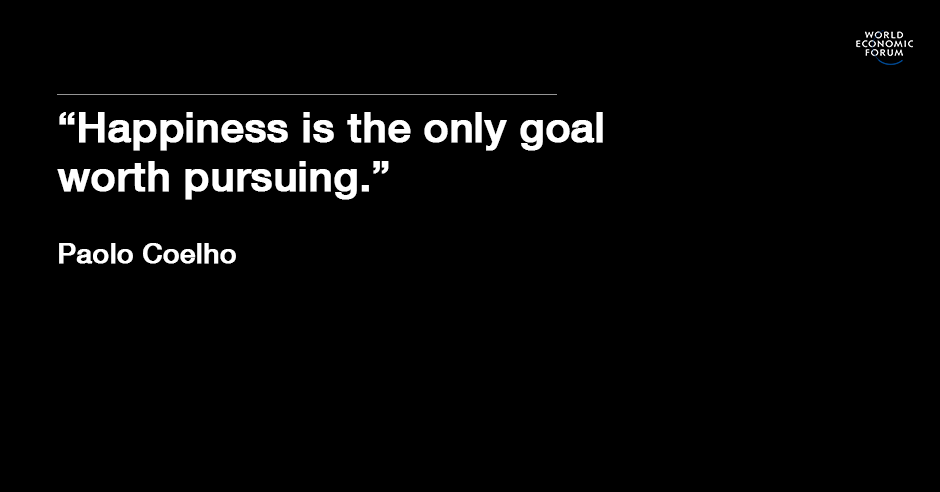Should happiness be a corporate goal?


Get involved with our crowdsourced digital platform to deliver impact at scale
Stay up to date:
Future of Work
This article is published in collaboration with SAP Community Network.
I just finished the book “Op naar geluk” *) from Ap Dijksterhuis, in which the author states that we are 50% in charge of your own happiness. Well… if it only was 1% then it would still be worth sharing a short summary with you. Especially so close to Christmas.
It’s a pleasant and quick read (it took me as true Epicurean only two days). Every chapter and statement is supported with interesting psychology research and vivid examples that make the read so easy to digest. It’s an accessible and popular collection of positive thoughts for any person in search for happiness.
Happiness, the highest goal in life?
Can you think of a higher goal in life than happiness? That’s hard right? Looking back in time, many philosophers from all eras have thought this through from different angles. From Socrates and Epicurus to Siddhartha and Confucius, they all concluded that happiness is a state of consciousness and something you can influence with a certain life style.
The stability of happiness
Dijksterhuis is an influential psychologist from the Radboud University and is keen on involving his readers into small tests like asking: How happy are you on a scale from 1 to 10? Making up your own mind as a reader, supported with scientific proof, leads to a thesis that happiness is more stable than you might think. It’s your consciousness which can’t be fully trusted when you analyze what makes you happy and what doesn’t make you happy. This concept is better explained in his first book “Het slimme onbewuste”*) from 2007.
Flow
The explanation of flow is one of the strongest models in the pursuit of happiness. Flow is the fantastic state of optimal experience. A model from Mihaly Csikszentmihalyi. Flow can be achieved by aligning skill and challenge in the most optical way, leading you to a state of happiness. It’s about a perfect balance between your comfort and learning zone, being creative and enjoy happiness in a wonderful pure form.
Intrinsic vs Extrinsic motivation
The way we motivate ourselves for our actions is important for our happiness. There is intrinsic motivation, which comes from the action itself. Like playing the piano because you love it. Extrinsic motivation comes from external factors. Like playing the piano because your parents told you so.
What makes this so interesting is the fact that we think we have a clear distinction between intrinsic and extrinsic motivation, but research tells us otherwise. Increased focus on what’s intrinsic leads to more happiness. A good example is the importance of learning versus the opportunity to earn money. Research clearly indicates that people who have a challenge and learn are much happier than people who choose extrinsic rewards, like money and status, in pursuit of a management position.
Never let a horizontal move (or even a demotion) prevent you from taking on a challenge that leads to happiness. It reminds me of a fantastic quote from Confucius.
Choose a job you love, and you will never have to work a day in your life.
Autonomy is key for happiness
Another important aspect of happiness is our need for autonomy, where Dijksterhuis pulls in the famous Maslow hierarchy of needs and comes to a powerful conclusion that any manager can use:
Intrinsic motivation declines with threads and external rewards. They subdue the feeling of autonomy and impact the chance on happiness.
Mindfulness leads to more happiness
No book on happiness without a thorough examination of the role of our ego and our mind wandering through the day. Ap Dijksterhuis goes through this quite simplistically, but hits a couple of key conclusions, like the power of now and the fact that you have an internal dialogue, but you are not your internal dialogue. The deeper people understand this, the better their fundament for happiness.
There is a confronting point in the book, stating the 183 billion e-mails we send to each other on a daily basis, making us mental slaves to check into this stream of information multiple times per hour or even minute, leaving us very vulnerable for procrastination and distancing us from focus, creativity and happiness.
Bring Happiness to School and Work
I wonder why we are so shy from using the word happiness more often in schools and business. The influence of our existing educational system on happiness is too indirect. There is sufficient knowledge from philosophy, psychology, sociology and neuroscience to enhance our current educational system and increase our social and emotional intelligence. The younger people can benefit from this knowledge, the better it is for the society as a whole.
And the same goes for work. Ever seen happiness of employees as a company goal? Engagement is the term we sometimes see. We need engagement to become happy, but happiness is clearly the higher goal in life. If not the highest goal. It wouldn’t harm to incorporate it more in our corporate goals, since it’s the intrinsic driver for success we desire so intensely.
The art of giving
Gandhi’s once said “Happiness depends on what you can give, not what you can get”. If you are still looking for a great Christmas gift, with the book Op naar geluk” from Ap Dijksterhuis you can’t go wrong. You can only make somebody happier.
Publication does not imply endorsement of views by the World Economic Forum.
To keep up with the Agenda subscribe to our weekly newsletter.
Author: Patrick Willer is a writer at The SAP Community Network.
Image: A share trader reacts as she sits behind her trading terminal. REUTERS/Kai Pfaffenbach.
Don't miss any update on this topic
Create a free account and access your personalized content collection with our latest publications and analyses.
License and Republishing
World Economic Forum articles may be republished in accordance with the Creative Commons Attribution-NonCommercial-NoDerivatives 4.0 International Public License, and in accordance with our Terms of Use.
The views expressed in this article are those of the author alone and not the World Economic Forum.
Related topics:
The Agenda Weekly
A weekly update of the most important issues driving the global agenda
You can unsubscribe at any time using the link in our emails. For more details, review our privacy policy.
More on Future of WorkSee all
Andrea Willige
February 29, 2024
Kara Baskin
February 22, 2024
Stephen Hall and Rebecca Geldard
February 19, 2024
Jason Walker and Deborah Circo
February 12, 2024







